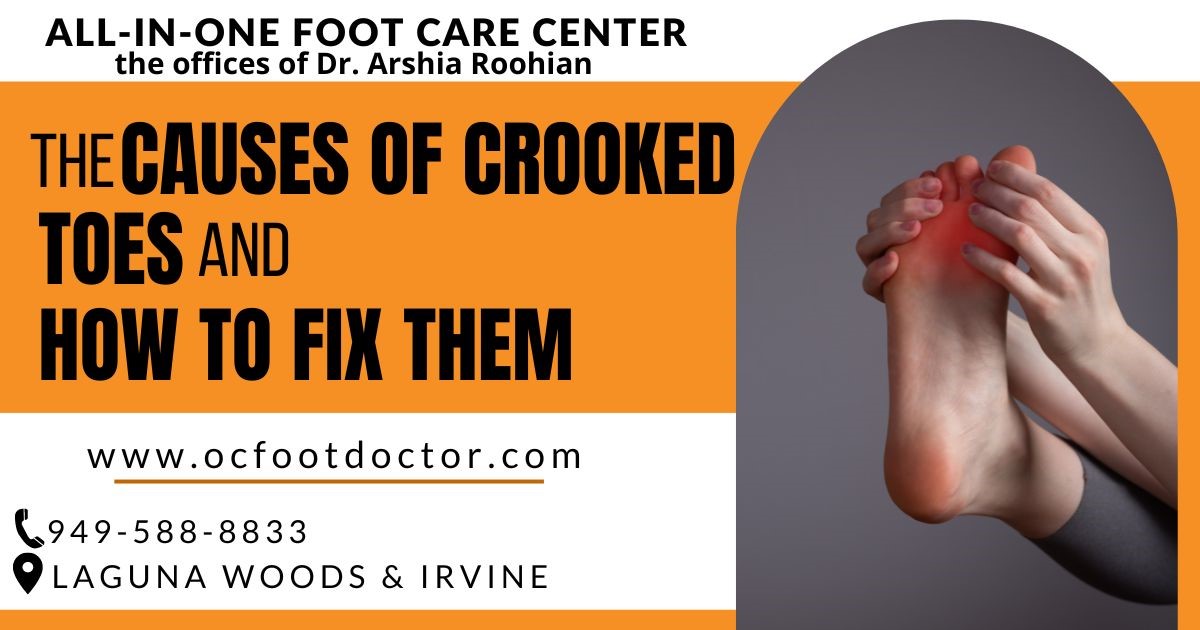The Causes of Crooked Toes and How to Fix Them

There are many types of crooked toes, including claw toes, mallet toes, and hammertoes, which are estimated to affect over 20% of the US population. Toes may also be pushed sideways, overlapping the next toe, or rotated from their original position as well.
Despite not being bothersome in and of itself, crooked toes often lead to additional symptoms such as corns, calluses, or open wounds. The more bent your toes get, the harder it becomes to find comfortable shoes. In the end, you may not be able to move your toes at all. Get your crooked toes fixed if they are causing other problems.
Crooked toes can be classified as follows:
Hammertoe
Hammertoes are abnormal bends at the proximal interphalangeal (PIP) joints of any toe, but are most common in the second, third, and fourth. A permanent bend of the toe is caused by an imbalanced muscle structure on the top and bottom of the toe when it is flexed (bent) upward for an extended period of time.
Mallet Toe
Toenail mallet toes are caused by an abnormal bend at the distal interphalangeal joint (DIPJ). As with this bend, a muscle imbalance is also responsible, this time it affects the flexor digitorum longus (FDL), a muscle that curls your toes (excluding the big toe). If this muscle tightens, the joint can become permanently bent if it tightens.
Claw Toe
This type of crooked toe is caused by both joints in the toe becoming bent, which causes the toe to bend under, turning the ball of the foot under in a claw-like shape.
Overlapping Toe
Occasionally, a toe can migrate beneath and over an adjacent toe due to a hereditary condition or to a bunion or hammertoe. Occasionally, a toe can migrate beneath and over an adjacent toe due to a hereditary condition or to a bunion or hammertoe.
Adductovarus Toe
In this condition, the toe bends toward one side of the foot, usually the fourth or fifth toe. Your toes may rub against each other or you may get calluses if your outer toe rubs against the sides of your shoes. A muscle or tendon imbalance may also cause this, except the toe is pulled at an oblique angle.
Crooked toes: why fix them?
If your toes are crooked, you need to take notice of them. Corns and calluses can become annoying. Shopping for shoes can be a nightmare for diabetics because rubbing inside shoes can cause calluses to turn into sores that are difficult to heal. Eventually, a crooked toe becomes rigid and cannot return to its normal position.
A crooked toe disrupts the weight distribution of the foot and absorbs pressure that was evenly distributed by your other toes, leading to pain and debilitating conditions.
Crooked toes: how to fix them
You may be able to prevent further deformity with lifestyle changes if your crooked toe is still flexible. The most important factor is choosing shoes with a wider toe box and a little longer. Avoid heels and shoes that squeeze your toes together. Your podiatrist may recommend a splint that holds a flexible toe straight.
To keep your muscles strong and balanced, it's important to stretch and flex your toes along with shoe changes. Using your toes, crumple a towel on the ground. Pull your toes gently outward and apart to stretch them. Physical therapists can assist you in designing an exercise program that is tailored to your needs.
It may be necessary to perform a surgical procedure if the toe has become completely rigid. All-In-One Foot Care Center will perform a small procedure to release the contracted muscle or tendon and straighten the toe. An outpatient procedure, with a few weeks of recovery time, is generally performed.
You can contact our office at 949-588-8833, or visit our website at https://www.ocfootdoctor.com. Our offices are in Laguna Hills, Irvine, Mission Viejo, Aliso Viejo, Lake Forest, Foothill Ranch, and Costa Mesa.
📲 949-588-8833
🏢 24331 El Toro Rd, Suite 370 Laguna Woods CA 92637
🏢Irvine Medical Arts Building 113 Waterworks Way, Suite 250 Irvine, CA 92618
🌐 https://www.ocfootdoctor.com/
The information contained above is intended for general reference purposes only. It is not a substitute for professional medical advice or a medical exam. Always seek the advice of your physician or other qualified health professionals before starting any new treatment. Health information on this website MUST NOT be used to diagnose, treat, cure or prevent any disease without the supervision of your doctor.


